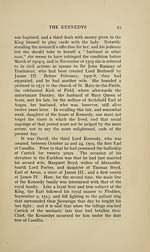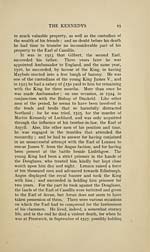Download files
Complete book:
Individual page:
Thumbnail gallery: Grid view | List view

14 HISTORY OF AYRSHIRE
By his first wife, Agnes, a daughter of William, Lord
Borthwick, the Earl had six children, four sons and two
daughters. Of these the eldest was Gilbert, the second
Earl. The second, William, was Abbot of Crossraguel,
1529-47. He is described as having been a good and a
great Abbot. He was present no fewer than eight times
at the National Parliament, and he was in addition a
member of the Privy Council. For many years he was
Commendator of the Abbey of Holywood, and was a
close friend of Gavin Dunbar, the Archbishop of Glasgow,
and of Henry, Bishop of Galloway. When his brother,
the second Earl, was assassinated in 1527, he acted as
tutor and guardian to the young Earl, his nephew, for
eleven years. In 1530 he obtained a safeguard, or
license, from the King to pass to France and other places
beyond the seas on his pilgrimage to Rome, and he
returned in time to attend the Parliament of 1532,
which instituted the College of Justice. After the
battle of Solway Moss, he was appointed a Commissioner
for holding Parliament, and voted for Arran as Governor
of the Kingdom. The insecurity of the times prompted
Gavin Dunbar to have his treasures and personal effects
deposited in the hands of the Abbot. The Archbishop's
will demonstrates how much valuable property had been
entrusted to his keeping ; richly embroidered vestments,
gold and silver goblets, jewels of the rarest kind, a
valuable library, and £4000 in money — these formed the
nucleus of the Prelate's property. Whatever may have
been the general morality of the period, and the unique-
views held under certain circumstances regarding the
transfer of property, it is evident that there was one
man in Carrick upon whom the Archbishop felt he could
implicitly refy. The Abbot served his Monastery and
his country well, and not a breath of scandal was raised
against his name. And, as might have been expected,
he was a good and a loyal Kennedy. He died before
the end of the year 1547, for it was on the opening day
of the next year that the Abbot Quintin was confirmed
his successor in the Monastery. He had been the heir
By his first wife, Agnes, a daughter of William, Lord
Borthwick, the Earl had six children, four sons and two
daughters. Of these the eldest was Gilbert, the second
Earl. The second, William, was Abbot of Crossraguel,
1529-47. He is described as having been a good and a
great Abbot. He was present no fewer than eight times
at the National Parliament, and he was in addition a
member of the Privy Council. For many years he was
Commendator of the Abbey of Holywood, and was a
close friend of Gavin Dunbar, the Archbishop of Glasgow,
and of Henry, Bishop of Galloway. When his brother,
the second Earl, was assassinated in 1527, he acted as
tutor and guardian to the young Earl, his nephew, for
eleven years. In 1530 he obtained a safeguard, or
license, from the King to pass to France and other places
beyond the seas on his pilgrimage to Rome, and he
returned in time to attend the Parliament of 1532,
which instituted the College of Justice. After the
battle of Solway Moss, he was appointed a Commissioner
for holding Parliament, and voted for Arran as Governor
of the Kingdom. The insecurity of the times prompted
Gavin Dunbar to have his treasures and personal effects
deposited in the hands of the Abbot. The Archbishop's
will demonstrates how much valuable property had been
entrusted to his keeping ; richly embroidered vestments,
gold and silver goblets, jewels of the rarest kind, a
valuable library, and £4000 in money — these formed the
nucleus of the Prelate's property. Whatever may have
been the general morality of the period, and the unique-
views held under certain circumstances regarding the
transfer of property, it is evident that there was one
man in Carrick upon whom the Archbishop felt he could
implicitly refy. The Abbot served his Monastery and
his country well, and not a breath of scandal was raised
against his name. And, as might have been expected,
he was a good and a loyal Kennedy. He died before
the end of the year 1547, for it was on the opening day
of the next year that the Abbot Quintin was confirmed
his successor in the Monastery. He had been the heir
Set display mode to:
![]() Universal Viewer |
Universal Viewer | ![]() Mirador |
Large image | Transcription
Mirador |
Large image | Transcription
Images and transcriptions on this page, including medium image downloads, may be used under the Creative Commons Attribution 4.0 International Licence unless otherwise stated. ![]()
| Histories of Scottish families > Ayrshire > Volume 2 > (24) Page 14 |
|---|
| Permanent URL | https://digital.nls.uk/95189386 |
|---|
| Attribution and copyright: |
|
|---|---|
| Description | A selection of almost 400 printed items relating to the history of Scottish families, mostly dating from the 19th and early 20th centuries. Includes memoirs, genealogies and clan histories, with a few produced by emigrant families. The earliest family history goes back to AD 916. |
|---|

